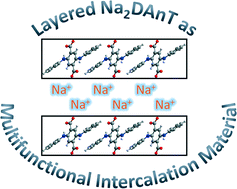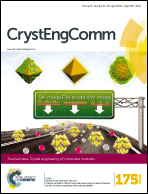Solvation, exchange and electrochemical intercalation properties of disodium 2,5-(dianilino)terephthalate†
Abstract
The development of intercalation chemistry in the early 70s has particularly enabled the deployment of novel and efficient electrode materials for electrochemical storage. A striking example is the commercialization of the first lithium-ion (rocking-chair) battery in 1991. Recently, a resurgence of new intercalation structures has occurred with the development of sodium-ion batteries, and therefore materials able to reversibly accommodate sodium ions in layered or porous solids (e.g., 3d transition-metal oxides). However, not only metal cations can be incorporated into multi-dimensional structures but also polar molecules and anions especially in 2-D host lattices where they can be accommodated through chemical or electrochemical reactions, respectively. Herein, we specifically report on disodium 2,5-(dianilino)terephthalate as a multifunctional organic intercalation material able to chemically exchange metal cations and accommodate organic polar molecules as well as host anions under electrochemical charging conditions. Powder X-ray diffraction measurements coupled with other analytical techniques were performed for evidencing the Na/Li exchange reaction as well as the solvent intercalation. Moreover, galvanostatic cycling tests and impedance spectroscopy measurements were performed to demonstrate the occurrence of anion intercalation process and the resulting effect on the conductivity of the analogous dilithium 2,5-(dianilino)terephthalate compound.

- This article is part of the themed collection: Crystal engineering of composite materials

 Please wait while we load your content...
Please wait while we load your content...